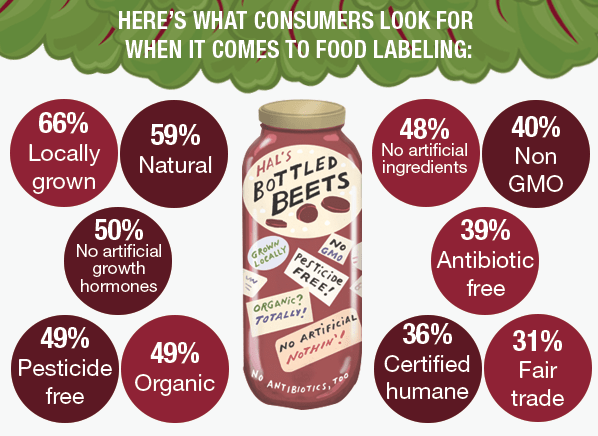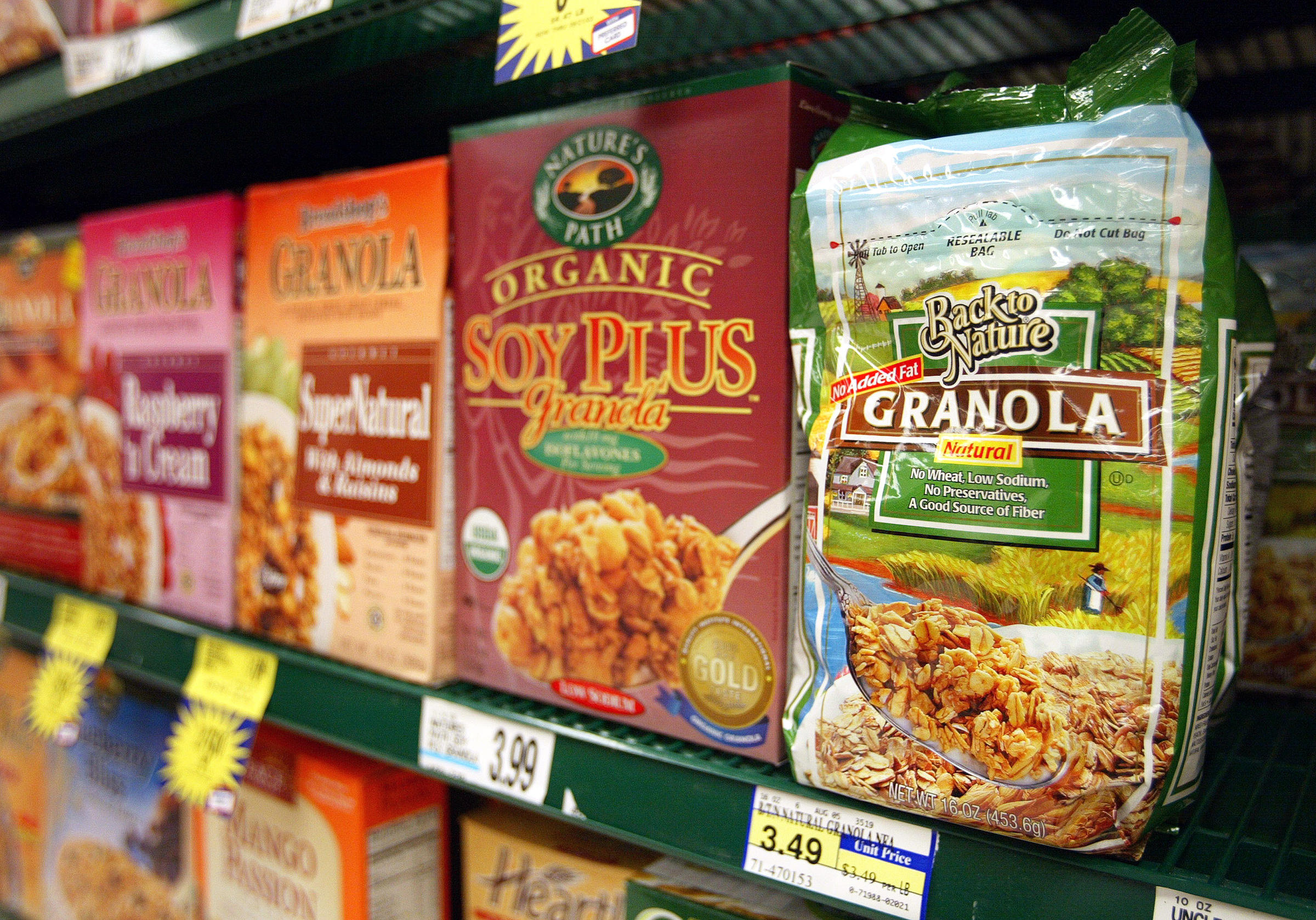43 organic food standards and labels the facts
These 68 Organic Food Statistics Predict Huge Market Shifts Top 10 Organic Food Statistics and Facts Over 90% of all corn in the United States is a product of genetic engineering. Over 71 million hectares of farmlands are organically cultivated globally. The UK had about 489,000 hectares of organic farms in 2020. Worldwide sales of organic foods will amount to $849.7 billion by the end of 2028. Can the Part Replace the Whole? A Choice Experiment on Organic and ... Chemical pesticides are a serious impediment to agricultural sustainability. A large-scale reduction in their use to secure food supplies requires more innovative and flexible production systems. Pesticide-free production standards bring together the strengths of all participants in the food value chain and could be the catalyst for this transition. Using a choice experiment approach and green ...
What Is Organic Food? Is Organic Food Better for You? - Reader's Digest Natural vs. organic foods The USDA requires that foods labeled "natural" be minimally processed and free of any artificial ingredients, certainly both good practices. But natural foods are not held...

Organic food standards and labels the facts
Understanding Organic vs Non-Organic Food Labels and Differences 2. Aesthetics of Fresh Produce. Many people argue that organic food looks and feels differently than non-organic food. They feel conventional food items almost look too "perfect;" whereas organic produce resembles the fresh fruit and veggies in your back yard garden with non-symmetrical shapes, varying colors and even some blemishes. en.wikipedia.org › wiki › Organic_foodOrganic food - Wikipedia Organic food, ecological food or biological food are food and drinks produced by methods complying with the standards of organic farming. Standards vary worldwide, but organic farming features practices that cycle resources, promote ecological balance, and conserve biodiversity . Organic Foods: What You Need to Know - HelpGuide.org Organic meat and milk can be richer in certain nutrients. Results of a 2016 European study show that levels of certain nutrients, including omega-3 fatty acids, were up to 50 percent higher in organic meat and milk than in conventionally raised versions. Organic food is GMO-free.
Organic food standards and labels the facts. Understanding Organic Foods - Unlock Food The difference between organic and non-organic (conventional) food has to do with how food is produced. For example, organic foods like vegetables, fruit, eggs, milk and meat are produced without: Synthetic (human-made) pesticides, herbicides and fertilizers. Organic farmers may use natural pesticides approved for organic food production. Organic Farming | US EPA More than 40 private organizations and state agencies (certifiers) certify organic food. But their standards for growing and labeling organic food may differ. For example, there are differences in: permitting or prohibiting different pesticides or fertilizers in growing organic food the language contained in approved seals, labels, and logos Organic foods: Are they safer? More nutritious? - Augusta Health The USDA guidelines describe organic foods on product labels as: 100% organic. This label is used on certified organic fruits, vegetables, eggs, meat or other foods that have one ingredient. It may also be used on food items with many ingredients if all the items are certified organic, except for salt and water. These may have a USDA seal. Organic. › legacy › afsicOrganic Production/Organic Food: Information Access Tools - USDA USDA Consumer Brochure: Organic Food Standards and Labels: The Facts. “What is organic food? Organic food is produced by farmers who emphasize the use of renewable resources and the conservation of soil and water to enhance environmental quality for future generations. Organic meat, poultry, eggs, and dairy products come from animals that are ...
Food Labeling & Nutrition | FDA Food labeling is required for most prepared foods, such as breads, cereals, canned and frozen foods, snacks, desserts, drinks, etc. Nutrition labeling for raw produce (fruits and vegetables) and ... Organic Animal Welfare Standards | OTA Consumer trust and integrity of the organic label - 89% of Americans say the USDA should periodically review and update the organic standards to keep pace with new science and consumer expectations. USDA Seeks Comments on Organic Livestock and Poultry Standards Proposed Rule › organic-food-labelsOrganic on Food Labels | FDA The USDA requirements for products that are labeled with the term "organic" are separate from the laws that FDA enforces. Food products that are ordinarily under FDA's jurisdiction and labeled with... Food Packaging Labels: How to Understand Nutrition Facts to Eat ... The USDA regulates the use of the term "organic" on food labels through its National Organic Program. Plants and animals with a USDA organic seal are 95% natural with no synthetic growth hormones, antibiotics, pesticides, biotechnology, artificial ingredients, or irradiation used in production or processing.
Organic Labeling and Logos - Get The Facts This means that it is technically legal for a company to use the word organic on their product label without any supporting evidence. In the United States, using the word 'organic' on your product label without displaying the USDA Organic logo and the name of your certifying agency will result in a minimum fine of USD 10, 000. Inorganic vs Organic foods: Which is nutritious? - Immunosciences Organic foods have been grown or farmed without the use of artificial chemicals, hormones, antibodies, or genetically modified organisms. In order to be organic, a food product must be free from artificial food additives. The most commonly purchased organic foods are fruits, vegetables, grains, dairy products, and meat. What is Organic Food? - Definition, Facts, Pros & Cons The regulations surrounding organic foods also apply to food labels. Organic brands can be found on produce, dairy, meat, and processed foods, Produce can be called organic as long as it's certified to have come from a farm following the organic guidelines for production. What Does an 'Organic' Food Label Really Mean? - The Takeout Within the USDA's definition of organic and what gets the department's certified label, there are four different organic labels a product could receive: 100% organic: This product is completely organic in that all ingredients meet that labeling standard. Organic: At least 95% of the product's ingredients are organic.
healthcareers.co › organic-food-statisticsOrganic Food Statistics About the 2020 Market (Infographic) Jan 02, 2020 · 5. Understanding the meaning behind different organic labels is crucial. (FamilyDoctor) Before you switch, remember one of the most important facts about organic food: know your labels. “100% organic” means the food has been grown and processed using FDA-approved methods and ingredients.

33 Which Of The Following Is Not An Fda Required Component Of A Food Packaging Label_ - Labels ...
Top 5 Organic Food Facts That May Change Your Eating Habits. - LinkedIn 1. Organic produce is less likely to contain pesticides. There are still some residues of industrial fungicides, herbicides, and insecticides present in conventionally grown food. 2. Organic food ...
› organic-food › art-20043880Organic foods: Are they safer? More nutritious? - Mayo Clinic Apr 22, 2022 · Also be careful not to mix up other common food labels with organic labels. For example, certified organic beef guidelines include pasture access during at least 120 days of grazing season and no growth hormones. But the labels "free-range" or "hormone-free" don't mean a farmer followed all guidelines for organic certification.
› rules-regulations › organicLabeling Organic Products | Agricultural Marketing Service Finished product is certified organic and produced in full compliance with the USDA organic regulations: entire product may be labeled organic and display the USDA organic seal; All instances of specific fibers in finished product are certified organic: label may claim the specific fibers are organic and identify the percentage of organic fibers
All About Organics - Organic Consumers Association Organic food is pure food. It's safer, more nutritious and free of chemical additives. Organic crops are grown without chemical pesticides or fertilizers and organic livestock are raised without antibiotics, growth hormones or other drugs. Organic food isn't genetically modified or irradiated. via-organica-huerto-young-plant-8733.jpg
Master's Paper | Why Buying Organic is Good for Public Health | ID ... And while the USDA will not say that it is healthier, the information that they provide about organic food products in the USDA Consumer Brochure: Organic Food Standards and Labels: The Facts, gives a favorable description of how organic food is produced and the impact it has on the environment. Date of publication. May 2008; DOI
Introduction to Ecolabels and Standards for Greener Products The Framework, developed through a multi-stakeholder consensus based process, provides a transparent, fair, and consistent approach to assessing private sector standards and ecolabels for recommendations to federal purchasers. The Framework encourages continuous improvement of both standards and ecolabels and the products and services that those standards and ecolabels address, while providing ...




Post a Comment for "43 organic food standards and labels the facts"